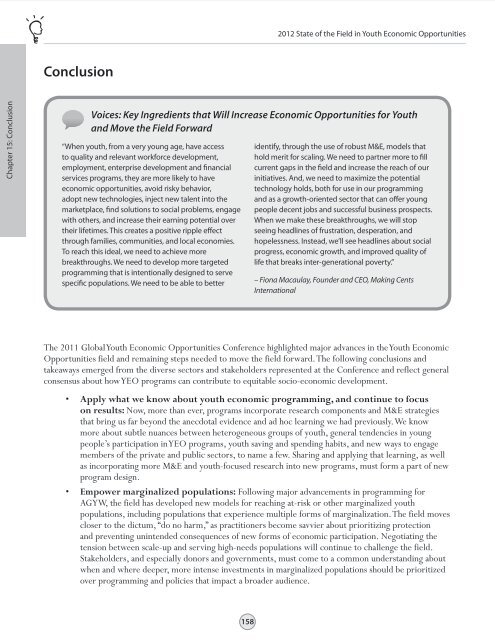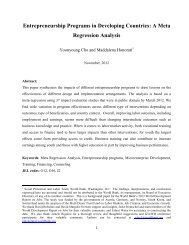STATE OF THE FIELD IN YOUTH ECONOMIC OPPORTUNITIES
STATE OF THE FIELD IN YOUTH ECONOMIC OPPORTUNITIES
STATE OF THE FIELD IN YOUTH ECONOMIC OPPORTUNITIES
You also want an ePaper? Increase the reach of your titles
YUMPU automatically turns print PDFs into web optimized ePapers that Google loves.
Table of Contents<br />
Chapter 9<br />
Chapter 1 Chapter 2 Chapter 3 Chapter 4 Chapter 5 Chapter 6 Chapter 7 Chapter 8<br />
Chapter 10 Chapter 11 Chapter 12 Chapter 13 Chapter 14 Chapter 15 Annexes<br />
2012 State of the Field in Youth Economic Opportunities<br />
Conclusion<br />
Chapter 15: Conclusion<br />
Voices: Key Ingredients that Will Increase Economic Opportunities for Youth<br />
and Move the Field Forward<br />
“When youth, from a very young age, have access<br />
to quality and relevant workforce development,<br />
employment, enterprise development and financial<br />
services programs, they are more likely to have<br />
economic opportunities, avoid risky behavior,<br />
adopt new technologies, inject new talent into the<br />
marketplace, find solutions to social problems, engage<br />
with others, and increase their earning potential over<br />
their lifetimes. This creates a positive ripple effect<br />
through families, communities, and local economies.<br />
To reach this ideal, we need to achieve more<br />
breakthroughs. We need to develop more targeted<br />
programming that is intentionally designed to serve<br />
specific populations. We need to be able to better<br />
identify, through the use of robust M&E, models that<br />
hold merit for scaling. We need to partner more to fill<br />
current gaps in the field and increase the reach of our<br />
initiatives. And, we need to maximize the potential<br />
technology holds, both for use in our programming<br />
and as a growth-oriented sector that can offer young<br />
people decent jobs and successful business prospects.<br />
When we make these breakthroughs, we will stop<br />
seeing headlines of frustration, desperation, and<br />
hopelessness. Instead, we’ll see headlines about social<br />
progress, economic growth, and improved quality of<br />
life that breaks inter-generational poverty.”<br />
– Fiona Macaulay, Founder and CEO, Making Cents<br />
International<br />
The 2011 Global Youth Economic Opportunities Conference highlighted major advances in the Youth Economic<br />
Opportunities field and remaining steps needed to move the field forward. The following conclusions and<br />
takeaways emerged from the diverse sectors and stakeholders represented at the Conference and reflect general<br />
consensus about how YEO programs can contribute to equitable socio-economic development.<br />
• Apply what we know about youth economic programming, and continue to focus<br />
on results: Now, more than ever, programs incorporate research components and M&E strategies<br />
that bring us far beyond the anecdotal evidence and ad hoc learning we had previously. We know<br />
more about subtle nuances between heterogeneous groups of youth, general tendencies in young<br />
people’s participation in YEO programs, youth saving and spending habits, and new ways to engage<br />
members of the private and public sectors, to name a few. Sharing and applying that learning, as well<br />
as incorporating more M&E and youth-focused research into new programs, must form a part of new<br />
program design.<br />
• Empower marginalized populations: Following major advancements in programming for<br />
AGYW, the field has developed new models for reaching at-risk or other marginalized youth<br />
populations, including populations that experience multiple forms of marginalization. The field moves<br />
closer to the dictum, “do no harm,” as practitioners become savvier about prioritizing protection<br />
and preventing unintended consequences of new forms of economic participation. Negotiating the<br />
tension between scale-up and serving high-needs populations will continue to challenge the field.<br />
Stakeholders, and especially donors and governments, must come to a common understanding about<br />
when and where deeper, more intense investments in marginalized populations should be prioritized<br />
over programming and policies that impact a broader audience.<br />
158

















